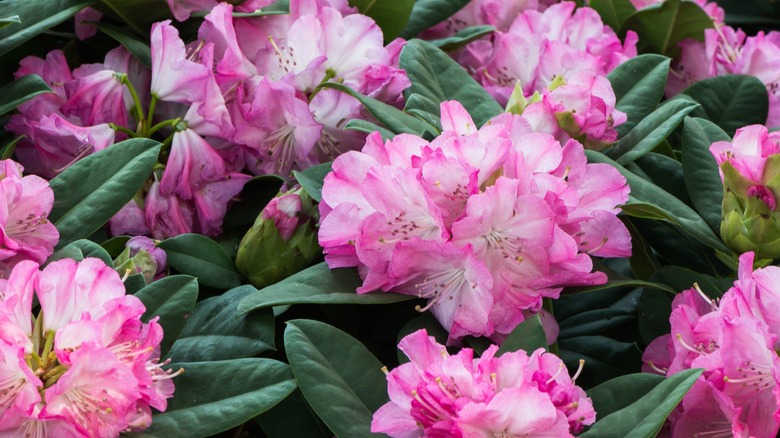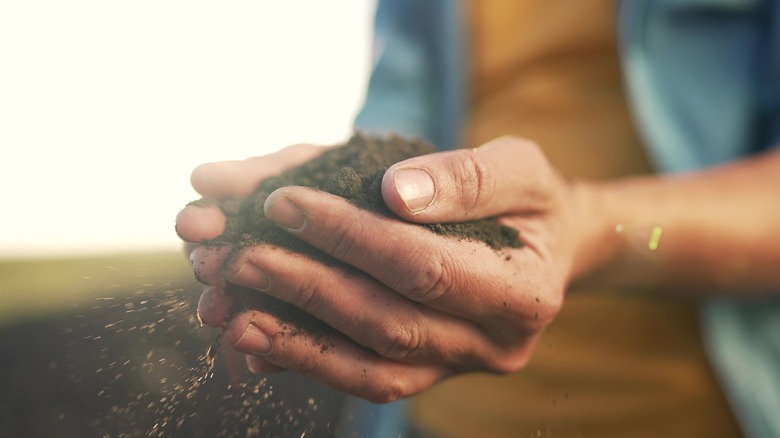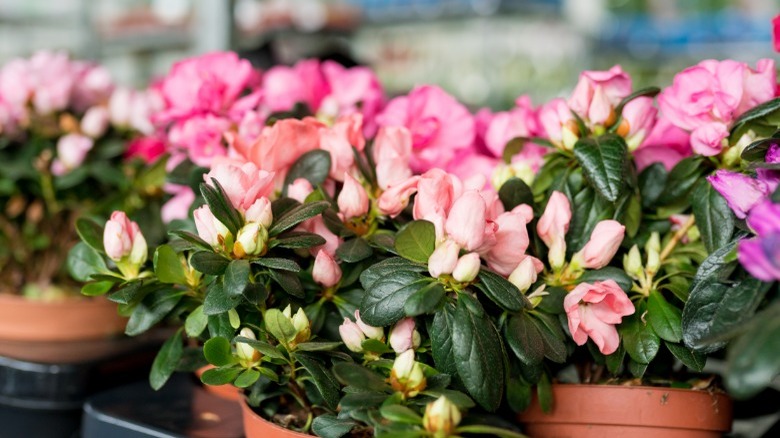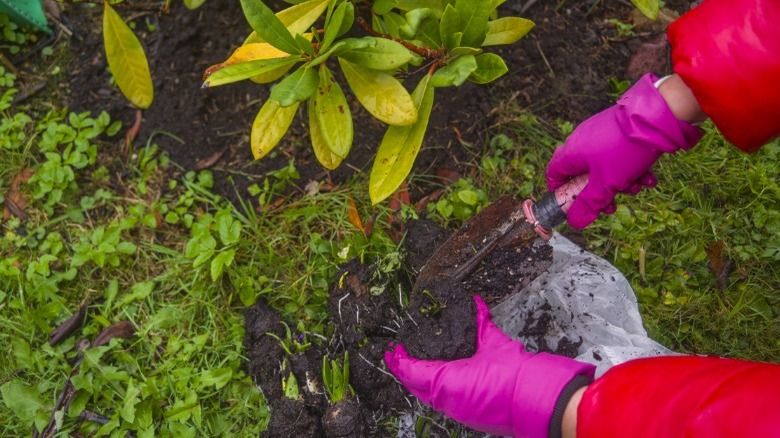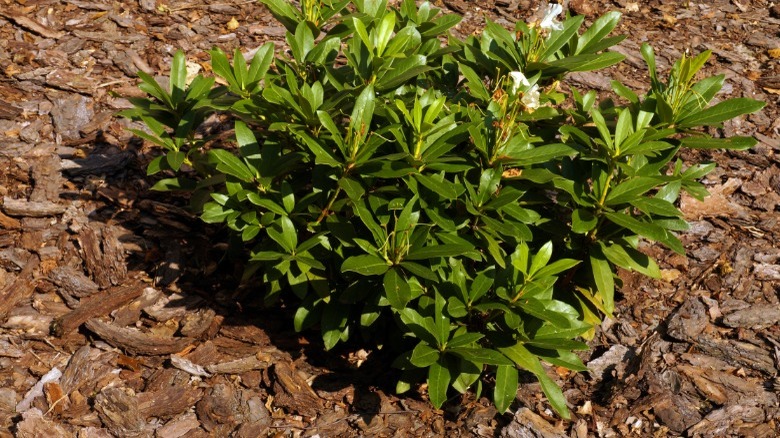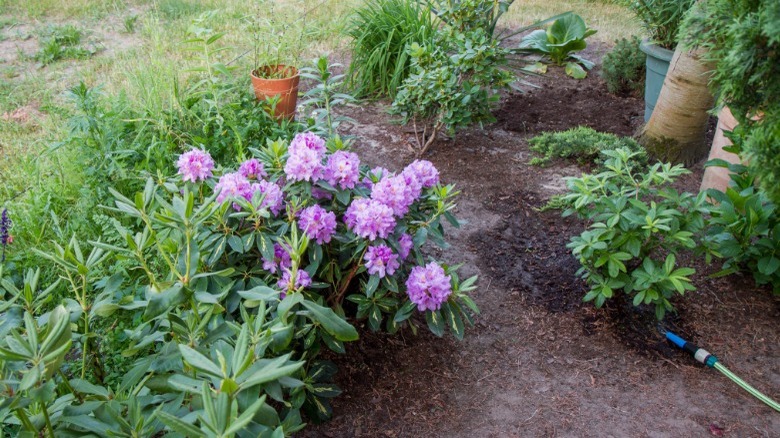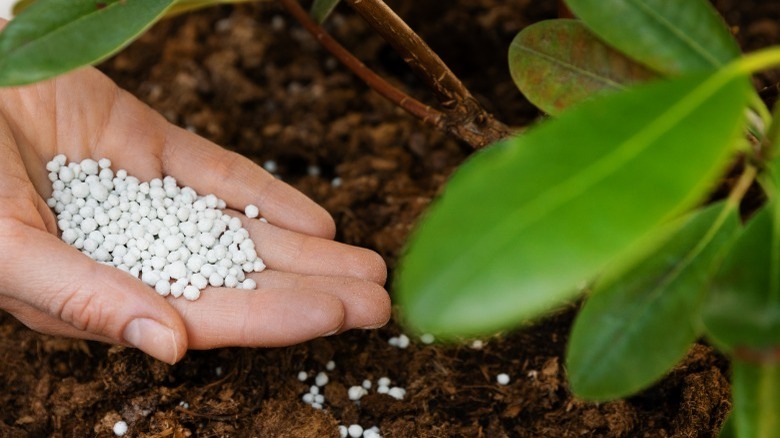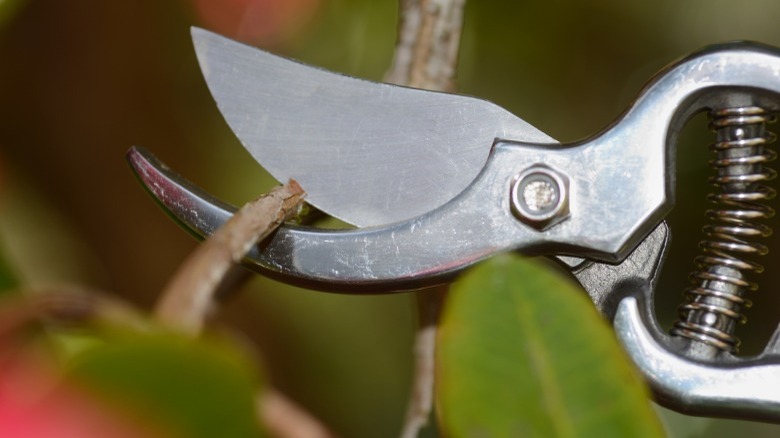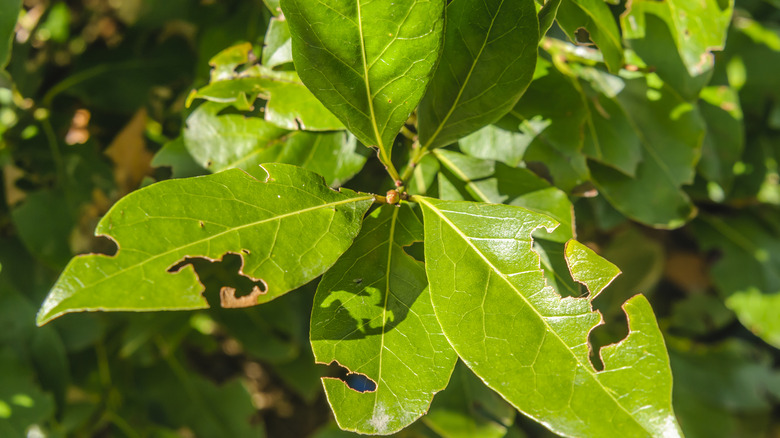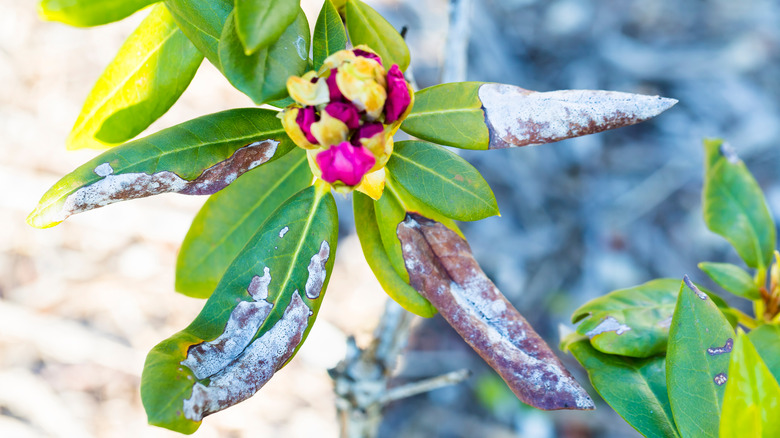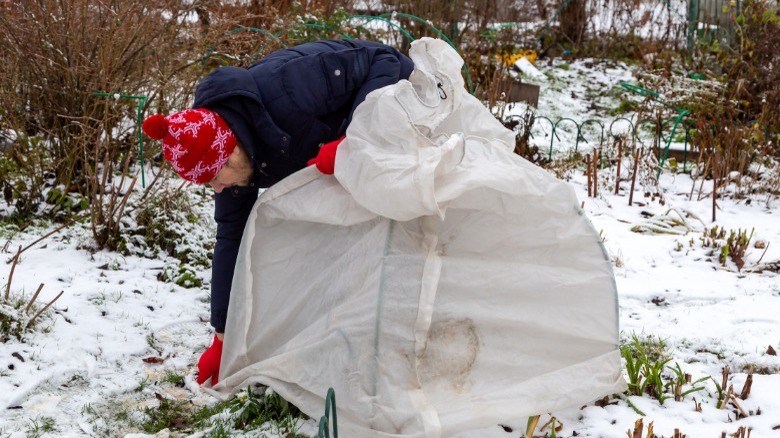The Best Ways To Care For Your Rhododendron Bushes
Rhododendron bushes are related to azaleas and can be cared for in much the same way. The two are card-carrying members of the genus Rhododendron but are classified as different species. Both have noticeably beautiful flowers, but they bloom at different times. They can also be evergreen or deciduous and drop their leaves in the fall. It's not always easy to tell the difference between these plants, since both have so many varieties and many have similar characteristics. The best way to recognize a rhododendron is to examine the stamens (male reproductive parts) inside the flowers. Rhododendrons have at least ten of these, but azaleas only have five. Rhododendron leaves are also larger, with an almost leather-like look and feel.
Gardeners love rhododendrons because they are a sign that spring has arrived. The heavy flower clusters add a great deal of color to landscapes and command attention. And due to years of hybridization, there are thousands of varieties to choose from. With the proper care, a rhododendron bush can reach its full potential and thrive for many years. Some can grow to be quite tall and look lovely on the fronts, sides, and backs of houses or as pretty focal points in garden beds. They are not known to be especially finicky outdoor plants. But if you want yours to do well, here are some important guidelines for site selection, planting, and maintaining one of these spectacular flowering plants.
Planting zones and light requirements
Showy flowers and shiny leaves make rhododendrons look like tropical plants but they also tolerate the cold. But too much bright sunlight is not optimal for these plants, and the best site location depends on what part of the country they're growing in. Rhododendrons are partial to USDA planting zones 5 to 8 but can be fine in zones 3 through 11. A deciduous rhododendron or azalea is most hardy up to zone 4, while evergreen varieties are most at home to zone 6. In the cooler parts of the country (zones 3-6), plant the shrubs in locations that get six full hours of sun each day to get the most flowers. These cooler regions of the U.S. are also more likely to experience freezing winds in the fall and winter, so you'll also want to choose areas that are shielded, like along walls and behind fences.
In general, rhododendrons prefer some coolness during the day and benefit from shade in the afternoon when the sun is the strongest. Filtered sunlight or a combination of morning sun and afternoon shade is best for these plants. So if you live in the hotter zones (6 through 11), your rhododendrons will need to be planted in spots that get a break from the brightness. This is especially true for the evergreen varieties. Ones that have smaller leaves might be better suited for heavy sunlight.
Choosing the right kind of soil
It's important to have the right kind of soil when planting rhododendrons and like roses, they prefer acidic, well-draining soil. When selecting a home for your new plant, order a kit to measure the pH of your soil. This will let you know if you need to alter it to make it more hospitable. The optimum pH for rhododendrons ranges from 4.5 to 6.0. If the soil is too acidic you can bring the pH up a bit by mixing limestone into the soil. However, if the pH is more than 6.0, use iron sulfate or agricultural sulfur to create the slightly acidic soil your plant needs to thrive.
The best soil for rhododendrons is rich in humus (decayed organic matter) and moist, but not overly wet. These plants have shallow roots that are easily damaged when they're too wet for too long. If your soil is not in the right shape for these plants, you can also enrich it with some peat moss or compost but that's not always necessary. Be careful, because too many soil amendments could alter the pH. And if the soil is waterlogged, the shallow roots will be vulnerable to mildew and fungal diseases. Either could damage or kill the plant.
Choose the right plant
Don't just grab the first rhododendron plant that you see at the garden center because an initial glance can be deceiving. Make sure that the leaves have a glossy, deep green color because yellowed ones will turn brown and fall off and could be indicative of a sick plant. And even if the plant seems to be healthy, feel the soil for moistness. Some garden centers overwater their plants, while others don't provide enough. And if you live in a warmer zone, don't be tempted by lower-priced smaller rhododendrons in one-gallon pots. Their roots are not that large or well-established, so they are more susceptible to damage. Instead, look for larger ones since they are hardier.
You'll also want to learn about the plant's blooming time since rhododendron varieties can flower in the spring through July. This is good to know, especially when you have other blooming plants and want to coordinate the times. And if the plant doesn't have a card showing its species, ask because it's smart to find out specifics like how tall the plant can get. You wouldn't want to plant a rhododendron that could shoot up too tall in front of your home's windows unless you want to block them.
How to plant rhododendrons
You'll want to pay careful attention to your rhododendron's root ball before lowering it into the ground. Wearing gardening gloves, carefully dig it out of the container and lay it gently on the ground. Then, remove your gloves and feel the soil around the roots. If it is dry, use clean gardening shears to slice in a few scores. Then, place it in a clean bucket and soak it in water until the roots and soil feel moist — those cuts will aid in water absorption.
While the root ball is in its spa, grab a shovel and start digging out the hole in your prepared soil. It should be a few inches deeper than the height of the ball, and three times as wide. Lower the root ball into the hole. If you dug to the correct depth the top of the ball should be slightly above the soil surface. Pat it down slowly, return half the soil, give it a good watering, and fill in the rest of the dirt. Then you can add in organic material like mulch or bark to give the rhododendron a good, healthy start.
How to mulch rhododendrons
New rhododendron plants will appreciate an initial mulching and mature ones like to be mulched annually. And though bark mulch works well you can also use pine needles and decomposed oak leaves. The purpose of mulch is to retain moisture around the plants, but it also prevents weeds, promotes flower growth, and protects the roots. Plus, mulch adds organic nutrients to the ground and keeps its temperature regulated. Keep your rhododendrons happy by adding one to two inches of it when planting and mulching once a year afterward, in the springtime.
If you choose to use fallen leaves or pine needles from your property to mulch your rhododendrons, don't use them if the trees were treated with herbicides. Products sprayed onto or applied on trees can leech into the ground if you use their leaves and needles for composting and this could harm your plants. You can add extra mulch if the pile looks like it needs to be revitalized, so check it every once in a while.
Watering rhododendrons
After the rhododendron has been planted, it will need to be watered well when the leaves start coming out and until they are fully formed The rhododendron's shallow roots are prone to damage from overwatering. But they will need special attention when it has not rained for a long time or if there is less than one inch of rainfall in any given week.
Water your rhododendrons in the early morning whenever possible because the sun's full force later in the day will make the moisture evaporate faster. You can water the plants with your hose, but aim it at the roots because watering from top to bottom can damage the foliage. Drip irrigation and soaker hoses work well for rhododendrons since they provide a slow, consistent water supply. If you choose to use a regular hose, do it slowly and keep an eye on the soil. If the water pools up and isn't draining, the plant is being overwatered. If this happens even when you aren't watering the rhododendrons, you might need to relocate the plant to another spot. This is a prime example of why it's so important to scout the best locations before planting.
How to fertilize rhododendrons
Mulching is not the same thing as fertilizing as the latter is about adding specific nutrients to the soil. Rhododendrons don't always need to be fertilized, and the results of a soil test will let you know whether or not it needs to be done. Some gardeners prefer cottonseed meals, but there are also fertilizers designed for rhododendrons and azaleas that contain ammonium nitrogen.
If you choose a healthy rhododendron, it shouldn't need to be fertilized when you plant it. But if it starts showing signs of stress like dying leaves or a lack of flowers, check for pests or diseases. If those are ruled out, you can add fertilizer. Do this in the early spring when the flower buds are starting to swell and follow the manufacturer's directions – adding too much will burn the rhododendrons. Also, avoid fertilizing once summer is underway. Doing so at this late stage could stimulate new growth that will be vulnerable to frostbite once it starts getting cold outside.
Trimming rhododendrons
The two ways to keep your rhododendron trimmed are deadheading and pruning. Deadheading encourages more flower production, and this is a proven method used on all kinds of flowering plants and shrubs. So once your rhododendron's flowers have started to wilt, get those garden shears and start taking off the faded blooms. Since rhododendron flowers grow in clusters, you can snip them off at the ends of each branch (called a truss). Cut right above the leaf collar and not below it. It can feel sad to remove these past-their-prime flower clusters, but remember that plants are still directing wasted energy toward them. Once it is deadheaded, a rhododendron will redirect its efforts toward making new flowers. And when removing the dead flowers, be aware that there are buds beneath the old heads so avoid disturbing them while you are working.
There is some debate about pruning rhododendrons. Some gardeners feel that these plants never need to be trimmed but you might want to keep yours neater or redirect its growth. They can be trimmed after they have finished flowering but if you do it too soon, the plant might not grow enough flowers during the next season. When you want to prune rhododendrons, cut individual branches instead of larger ones that have several growing out of them. Prune those smaller ones down to the spot right before they join the mother branches and only cut the larger ones if the rhododendron has gotten out of control. The next season, new branches will come out from the stubs. To redirect growth in young rhododendrons, remove a branch's main leaf bud at the tip. This will encourage the side buds to grow, making the plant fuller.
Dealing with pests
Humans aren't the only ones who appreciate rhododendrons — root weevils, spider mites, and lace bugs like them, too. Root weevils are tiny and look like dark beetles. You'll find them chomping away at the leaf edges, but most of the time the damage isn't significant unless the plants are small. Its grubs are often found in young, potted rhododendrons, so remember to check the root ball when you take it out of the pot. These pests are most active at night so if you notice the damage during the day, search for them later with a flashlight and physically remove them from the leaves.
Other insects (like aphids, leaf rollers, and caterpillars) can be found on the undersides of leaves and other parts of the plants. There are chemical herbicides that work on these pests, but organic methods can also eradicate them. One option is to introduce nematodes into the soil. Other natural enemies of these insects include horticultural sprays and insecticide soaps. These don't contain harmful chemicals but may need to be applied more often. Just be sure to dilute these products according to the label's instructions, coat the leaves well, and avoid using them before rain is predicted. That will wash them away, dispersing them into other parts of the garden.
Rhododendron diseases
As with any other outdoor plant, rhododendrons should be monitored for diseases and fungi. Some of these conditions are unattractive but are relatively harmless, while others can be deadly. Powdery mildew looks like someone sprinkled talcum powder on the leaves, which can be pulled off the branches. Otherwise, the foliage will fall off on its own and the plant is usually fine. If powdery mildew worsens, there may be circular, colored (yellow, brown, or purple) lesions on the leaves. When rhododendrons develop these kinds of symptoms, they may need to be treated with an anti-fungal product or pulled up out of the ground and destroyed. Another disease called stem dieback comes from a different kind of fungus and presents with wilted leaves. Those should also be removed quickly and disposed of.
To prevent these fungal diseases, don't plant rhododendrons too close to each other, and be vigilant about removing dead leaves and anything else that could cause the ground to retain moisture. And when you remove infested leaves, wear gardening gloves and sterilize your pruning tools with isopropyl alcohol when finished to kill any remnants that are on them. If not, the fungus can easily spread to your other plants and into the ground.
Winter care for rhododendrons
Evergreen rhododendrons can survive in chilly temperatures and curl up their leaves when it gets too cold for them. This appearance has been compared to slim green cigars. And the colder it gets, the tighter they are. It seems as though the plant does this to retain heat but it may also conserve water and prevent snow and ice accumulation. This is not a serious condition and when it gets warm enough, they will open back up. Very cold winds can damage rhododendron leaves because any moisture in them evaporates. Rhododendron leaves will freeze when temperatures dip to 17.6 degrees Fahrenheit, which is well below freezing.
So when a real cold snap is predicted, you can cover up your plants with sacks made for this purpose, and create windbreaks made from lattice or fencing. Be sure to secure sacks with ropes and stakes, otherwise, they could take off with the wind and end up on your neighbor's lawn. Now is also a good time to add about four inches of mulch which will protect the soil from freezing. Once temperatures are back up, remove the sacks and check the plants for damage, removing any branches that didn't survive. Then. give the rhododendrons a good drink of water and they should spring back in no time.
